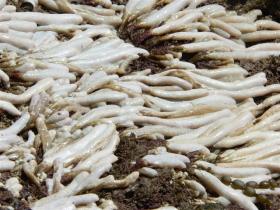Australian droplet tunicate

[Image: Crispin Middleton, NIWA]
Status in New Zealand
Present in some areas of New Zealand
Legal Status in New Zealand
Under management
Description
The Australian droplet tunicate is an ascidian native to Australia, which forms large colonies that attach to hard substrates. It is generally found in muddy bottomed tidal habitats and on man-made structures such as wharf piles and aquaculture equipment. It is generally submerged just below the waterline, but can often be seen at low tide. The size of the Australian droplet tunicate in New Zealand is influenced by seawater temperatures, with it decreasing in size over the winter months, but rapidly re-growing to its full size once summer arrives.
Why is it a problem?
The Australian droplet tunicate forms dense colonies, smothering beaches, rocks and tide-pools. It displaces native species and grows on boats, aquaculture equipment and other marine structures. It was first reported in New Zealand in early 2005, but was not originally regarded as a pest, given its low density and the fact it appeared to die off in winter. In the summer of 2007-2008 it became more prolific in a number of locations in Northland and has continued to reappear over the summer months.
A swim over the Australian droplet tunicate in Whangarei Harbour. [Video: Shaun Lee]
What do they look like?
|
Download an identification guide
Find out more about this species
Related content
- Page, M. J., Morrisey, D. J., Handley, S. J. and Middleton, C. (2011). Biology, ecology and trials of potential methods for control of the introduced ascidian Eudistoma elongatum (Herdman, 1886) in Northland, New Zealand Aquatic Invasions 6: 515-517 [PDF 1.1 MB]
- Morrisey, D., Page, M., Handley, S., Middleton, C., Schick, R. (2009). Biology and ecology of the introduced ascidian Eudistoma elongatum, and trials of potential control options. MPI Technical Paper No: 2009/21. 63 p. ISBN No: 978-0-478-35139-2 [PDF 3.1 MB]
